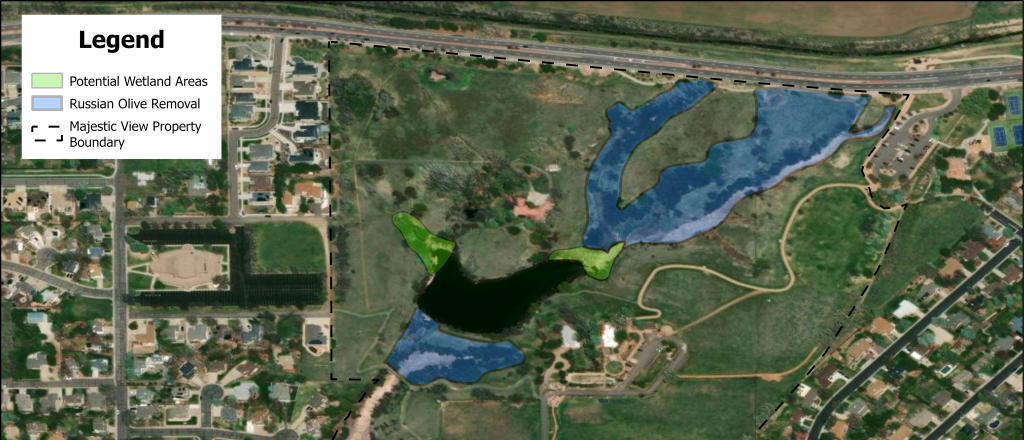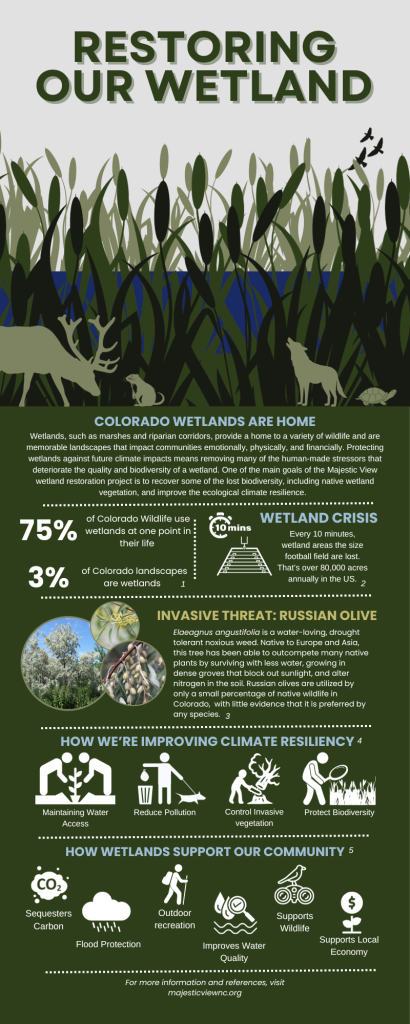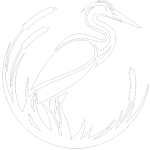Taking Lasting Care of Wetlands

The Majestic View Wetlands are primarily in the wildlife resting areas of the 80 acre park. These emergent marshy habitats are home to a variety of plants and wildlife, some invasive and problematic. To preserve the quality and the beauty of the wetlands and lake, and to support as many native species as possible, work is being done to conserve the water and revegetate native plants.
The Problem
- As visitors may have noticed, the lake has less water than historical levels. Over the last several decades, the lake has filled up, bottom up with silt from erosion and cattail encroachment, reducing the water capacity of the lake. No intervention would lead to the Oberon Lake filling in completely with soil & cattails, eliminating most if not all aquatic habitat.
- Invasive vegetation is choking out habitat and drinking up storm water, reducing the amount of water available for native plants and wildlife in the wetlands and lake. Invasive vegetation also supports fewer species of wildlife, sometimes causing more problems by reducing preferred food or shelter sources. No intervention would mean a continued loss of biodiversity and potential for no water/dry seasons in the lower marsh.
The Solution
- We’re partnering with experts, such as Ducks Unlimited, Colorado Parks & Wildlife, Colorado Water Conservation Board, Volunteers of Outdoor Colorado, and others to determine the best course of action.
- Thanks to our partners, this project has received over $250,000 in grants for restoration work.
- Removing noxious weeds, such as Russian Olive trees (Class B) and Teasel (Class B), and replanting native vegetation such as Swamp Milkweed, Marsh Aster, Willows, and more.
- Fun fact: Russian Olive trees can drink up to 100 gallons of water a day. That’s the same amount of water as if each tree took 1-2 bathtubs of water a day, everyday.
- Preventing further silt build up in the lake with maintenance spillways in the wetland areas where water enters the lake

Timeline
- This is a multi-year restorative process, with stages affected by migration seasons, weather, funding, and volunteer availability.
- With the support from various grants, we anticipate most of the disturbance being complete by 2027. Further monitoring and revegetation effort will continue for the next 5-10 years.

Common Questions
- Why not dredge the lake?
- The cost is the biggest challenge, likely hitting the $1 million range. Part of that is the cost to displace the silt and mud from the bottom of the lake–there is no dumping ground for that type of soil nearby and is difficult to haul up the hill to a transport vehicle. It would also cause disturbances and have wider impacts on everything from nature center programming, park usage, and wildlife.
- What will happen to wildlife?
- Wildlife is incredibly resilient. Working in phases allows time for wildlife to adapt and move around the disturbed areas. Some wildlife may bounce back even stronger, which will be seen with continued wildlife monitoring.
- How are we monitoring?
- We have staff and volunteers that conduct visual observations and bio blitzes periodically, but we also have wildlife cameras operating 24/7 that capture wildlife and their behavior.
- We periodically check the water quality and depth, looking for data such as bacteria overgrowth, temperature, PH, salinity, etc. We also look at indicator species, invertebrates that have known tolerance to pollutants can determine water quality by what is abundantly found.
- Why are we intervening?
- There is no such thing as “pristine” natural areas, as ecosystems change over time. The Oberon Lake was a man-made reservoir created in the early 20th century for the Town of Oberon. Before then, this area was primarily short-grass prairie with a few trees near the low-lying marshy areas. Frequent grass fires kept vegetation in check and a larger variety of species utilized this area for resting, nesting, and migration.
- Humans have stewarded this area for centuries, but humans have also negatively impacted the area more recently. In the 1960s & 1970s, many landowners planted Russian Olive trees around their houses as fast growing, easy to spread windbreaks. These trees did spread and now are found throughout the wetland. This is one example of the many “anthropogenic” impacts affecting the ecosystems here in the park.
- Will this impact the views?
- While there may be a noticeable change in the landscape with fewer Russian Olive trees or the removal of some of the cattails, this disturbance is temporary. As we work towards long-term restoration, the views should remain wild, tranquil, and full of birds and flowers. As native vegetation fills in over the next several years, there will be a change in vegetation but still plenty of nature to maintain the views and habitat structure for wildlife.
Comparing 1963 to 2019, Many Changes Over Time
Even just 60 years ago, the landscape looked very different. While we recognize ecosystems change over time and will likely look very different in another 60 years, we are hoping to slow those changes. Preserving water and reducing human impacts on the wetlands help our plants and wildlife adapt and hopefully continue to thrive in our community for many more years to come. (Photo on left taken by aircraft in 1963, photo on right from Google aerial imagery circa 2019).

Have more questions, concerns, or see something interesting in the wetlands? Please send your inquiries to the Nature Center Director at ahoover@arvada.org.

